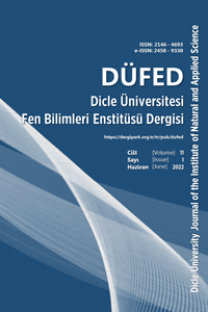Banki Türbini Verimlilik Artışı için Tasarım Parametrelerinin Sayısal ve Deneysel Olarak İncelenmesi
Bu çalışmada, Banki hidrolik türbininin verimini artırmak için türbin kanat sayısını optimize edip yeni çark modeli oluşturmak amaçlanmıştır. Debi ve düşü değerleri bilinen türbinin tasarım değerleri analitik yollarla hesaplanmıştır. Kanat sayısı için literatürde kabul gören bir analitik yol bulunmamaktadır. 7 farklı kanat sayısı denenerek bu çarkın sayısal analizi ANSYS CFX yazılımıyla gerçekleştirilmiş ve analiz sonucu değerlerinden en yüksek verime sahip olan 30 kanatlı çark imal edilmiştir. 0,2 m3 debi ve 65 metre düşü değerleri baz alınarak oluşturulan türbin modelinin sayısal çalışması deneysel testler ile doğrulanmıştır. Sayısal ve deneysel çalışmalar 30 kanatlı türbin için farklı debilerde verimi bulmak için tekrarlanmıştır. Türbin deneysel testlerde %74,91, HAD analizleri sonucunda %76,85 maksimum verim değerine ulaşmıştır. Bu sonuçlarla sayısal ve deneysel test sonuçlarının uyum içinde olduğu ve maksimum verim değerinin belli debi aralığında gerçekleştiği görülmüştür. Önerilen sayısal analiz yöntemiyle en yüksek verimi veren kanat sayısı farklı modelleri imal etmeye gerek kalmadan belirlenebilir.
Anahtar Kelimeler:
Banki türbin tasarımı, Banki CFD analizi, Banki türbin verimi, Banki deneysel testler
Numerical and Experimental Investigation of Design Parameters for Efficiency Increase of Banki Turbine
In this study, it is aimed to create a new runner model by optimizing the number of turbine blades in order to increase the efficiency of the Banki hydraulic turbine. The design values of the turbine, whose flow and head values are known, were calculated analytically. There is no accepted analytical method in the literature for the number of blades. Numerical analysis of this runner was carried out by ANSYS CFX software by testing 7 different blade numbers and 30 bladed runner with the highest efficiency were produced from the analysis results. The numerical study of the turbine model, which was created based on 0.2 m3 flow and 65 meters head values, was verified by experimental tests. Numerical and experimental studies were repeated for 30 bladed turbines to find efficiency at different flow rates. The turbine reached a maximum efficiency of 74.91% in experimental tests and 76.85% in CFD analysis. It has been seen that these results are in agreement with the numerical and experimental test results and the maximum efficiency value is realized in a certain flow range. With the proposed numerical analysis method, the number of blades that give the highest efficiency can be determined without the need to manufacture different models.
Keywords:
Design of the banki turbine, CFD analysis of the banki, Efficiency of the banki, Banki experimental tests,
___
- J. D. Andrade, C. Curiel, F. Kenyery, O. Aguilon, A. Vasquezand, M. Asuaje, “Numerical Investigation of the Internal Flow in a Banki Turbine”. International Journal of Rotating Machinery, vol. 2011, 2011, doi:10.1155/2011/841214.
- A. N. Bilal, “Design of High Efficiency Cross-Flow Turbine for Hydro-PowerPlant,” International Journal of Engineering and Advanced Technology, vol. 2, no 3, pp. 308-311, 2013.
- M. Patel, N. Oza, and K. Patel, “Computational Fluid Dynamic Analysis of Cross Flow Turbine,” International Journal of InnovativeResearch in Science Engineering and Technology, vol. 5, no 9, 2016, DOI:10.15680/IJIRSET.2016.0509059.
- M. San and N. Nyi, “Design of Cross Flow Turbine and Analysis of Runner's Dimensions on Various Head and Flow Rate,” International Journal of Scientific and Research Publications, vol 8, no 8, pp. 586-592, 2018, DOI: 10.29322/IJSRP.8.8.2018.p8076.
- A. Dragomirescu and M. Schiaua, “Experimental and numerical investigation of a Banki turbine operating far away from design point,” Sustainable Solutions for Energy and Environment, EENVIRO 2016, Bucharest, Romania, 26-28 October 2016.
- V. Sammartano, C. Arico, A. Carravetta, O. Fecarottaand T. Tucciarelli, “Banki-Michell Optimal Design by Computational Fluid Dynamics Testing and Hydrodynamic Analysis,” Energies 2013, 6, 2362-2385, doi:10.3390/en6052362.
- R. Adhikari and D. Wood, “The Design of High Efficiency Cross flow Hydro Turbines: A Review and Extension”, Energies, vol. 11, no. 2, 2018, https://doi.org/10.3390 /en11020267.
- S. Sirojuddin, L. K. Wardhana and A. Kholil, “Investigation of the draft tube variations against the first stage and the second stage flow of banki turbine”, IOP Conference Series: Materials Science and Engineering. 1098, 062077, 2021, doi:10.1088/1757899X/1098/6/062077.
- TS EN ISO/IEC 17025, Deney ve kalibrasyon laboratuvarlarının yeterliliği için genel şartlar, TSE, 2017.
- İ. Çallı, Uygulamalı Hidrolik Makineler, Ankara, Seçkin Yayınevi, 3. Baskı, 2017.
- T. Chandran, P. Surendran and J. Chandapillai, “Design methodology and structural analysis of crossflow türbine,”Innovative Solutions in Flow Measurement and Control - Oil, WaterandGas” August28-30, 2017, FCRI, Palakkad, Kerala, India.
- C. Özgür, Su Makinaları Dersleri, İstanbul, Teknik Üniversite Matbaası, 3. Baskı, 1977.
- Entec Consulting&Engineering, Cross Flow Design, Switzerland, 2003.
- H. Başeşme, Hidroelektrik Santraller ve Hidroelektrik Santral Tesisleri, Ankara, EÜAŞ yayınları, 2. Baskı, 2003.
- Autodesk Inc., Inventor 2022 Professioal, USA, 2022.
- Ansys Inc, CFX, USA, 2018.
- Ansys Inc, Fluent User Guide Manual, USA, 2018.
- D. Popescu, C. Popescu and A. Dragomirescu, “Flow control in Banki turbines,” 4th International Conference on Energy and Environment Research, ICEER 2017, Porto, Portugal, 2017, doi:10.1016/j.egypro.2017.10.272
- B. M. Uyar, J. Caoand Z. Wang, “Experimentaland CFD simulation validation performance analysis of Francis turbine,” IOP Conf. Series: Earth and Environmental Science, 1037, 012003,2022, doi:10.1088/1755-1315/1037/1/012003
- Md. M. Kamal, G. Saini, A. Abbas and V. Prasad, “Prediction and analysis of the cavitating performance of a Francis türbine under different loads,” Energy Sources, Part A: Recovery, Utilization, and Environmental Effects, 2021, doi: 10.1080 /15567036.2021.2009941
- ISSN: 2146-4693
- Yayın Aralığı: Yılda 2 Sayı
- Başlangıç: 2012
- Yayıncı: Dicle Üniversitesi
Sayıdaki Diğer Makaleler
Yok Olan Kültürel Miras: Mardin Muzafferiye Medresesi
Sabri KARADOĞAN, Mehmet Tahir KAVAK, Aladdin AL
Yüksek Hızlardaki Hava Akışının Farklı Kanat Profillerine Etkisi
Yusuf Can AKAR, Ramazan SELVER
Sibel İPEKEŞEN, Muhammed İsmail AKYILDIZ, Aydın ALP
Şafak ÖZHAN KOCAKAYA, Abdulselam ERTAŞ, İsmail YENER, Enes ARICA, Demet DİNCEL
Banki Türbini Verimlilik Artışı için Tasarım Parametrelerinin Sayısal ve Deneysel Olarak İncelenmesi
